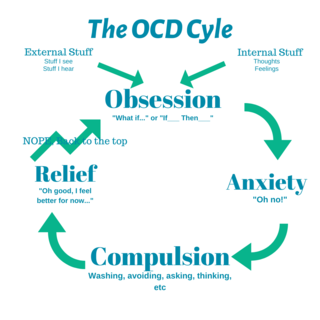OCD
What the Mental Compulsions of OCD Look and Feel Like
Beyond hand-washing, mental compulsions are the "silent but deadly" form of OCD.
Posted July 28, 2022 Reviewed by Tyler Woods
Key points
- Obsessive-Compulsive Disorder is an anxiety disorder causing excessive doubt and uncertainty that is maladaptively addressed through compulsions.
- Obsessive-Compulsive Disorder can have both overt, outward compulsive behavior as well as covert, internal compulsions.
- Mental compulsions are no less significant or problematic than outward compulsions, though they can be more difficult to identify.
We all know what Obsessive Compulsive Disorder (OCD) is, right? Handwashing. Cleaning a lot. Checking the stove. Organizing your books by color or size or topic or author. If you have a really exotic manifestation, you might circle back when you drive, just to make sure you didn’t run over a pedestrian or cat that didn’t deserve it. That’s pretty much it, right?
By now, hopefully, you’ll hear my sarcasm.
If you have lived experience with OCD, or know someone who does, you may know that OCD goes well beyond these external behaviors and also includes hidden actions that are as tricky as they are sinister.
Mental compulsions, also known as covert compulsions, are compulsive behaviors, actions, or efforts that occur inside the mind and body. Just because you can’t see them does not mean they are easier to deal with, have less of an impact on your life, or are in any other way “less than” the outward compulsions that people see and which are much easier to portray on a TV show or in a movie character.
What is OCD?
For the uninitiated, let me briefly go over what the OCD cycle is.
It all starts with a trigger. This can be literally anything, including something outside of you, like seeing children play, hearing a song, or seeing a random scene in a movie. Triggers can also come from inside of you, like having a random mental image of a boat pop into your mind, feeling your heart flutter, or even that abstract feeling of being “nudged or drawn” toward or away from something.
This starts an obsession that leads to a doubt, uncertainty, and an anxious feeling. “Oh no, does that mean I want to do _______?” Or, “If that were to happen, that would be terrible!” These doubts raise questions about who you are, what you want, and what will happen to you.
To feel better, safe, and confident again, or to feel sure that the obsession won’t happen, you engage in a compulsive behavior, which can bring a feeling of reassurance, avoidance, ritual, or routine that somehow works to quell the triggering thought or feeling. Usually, the compulsive behavior works...until it doesn’t.

For example:
Trigger: Touching a door knob
Obsession: What if it wasn’t clean and I could get sick?
Compulsion: Wash hands
What Are Mental Compulsions?
Alongside the myriad of external compulsions, you can also experience and engage with internal compulsions that are just as problematic to your recovery. While this list may be limited, and may not describe all examples of these mental compulsions, let’s go over a few of them, then see them in action.
Mental Avoidance: Trying to prevent a topic from coming to mind. “Don’t think about the white elephant.”
Thought Suppression: Working to force a thought out of your head.
Counting: Performing acts in a specific manner due to a belief that certain numbers hold special significance. This can be counting up to a certain number, counting by certain intervals, or counting in sets of numbers.
Tracking: Keeping track of items' or peoples’ location, orientation, quantity, qualities, etc.
Mental Review: Going over a previous interaction to evaluate your actions or the actions of others.
Emotional Checking: Evaluating your feelings, bodily sensations, or emotional states for the presence or absence of good, bad, right, or wrong feelings. “Do I feel love? How much? Enough love?”
Rumination: A seemingly never-ending mental evaluation and comparison. Thinking about something that leads to more thinking but never any real action.
Mental Rehearsal: Trying to play out all possible scenarios of a future event in your head. This is usually done to plan out the right thing to do, or get certainty that you won’t do the wrong thing.
Mental Checking: Mentally looking for a thought or feeling. “Am I thinking it? Do I feel that sensation? Is it still there, or did it go away?”
Memory Hoarding: Effortfully working to hold onto thoughts, memories, or experiences.
Compulsive Prayer: Engaging with or repeating prayers until they are done completely “right” or elicit the “appropriate and adequate” feeling.
Scenario Twisting: Mentally changing a few details of a previous event to see how they would change your current situation or feeling, and how those changes would improve or worsen your imagined future.
Self-Reassurance: Assuring yourself that you are “Ok,” “safe,” and that everything is as it should be.
Mental Compulsions and OCD
Now, let’s see a few of these in action:
Relationship OCD (ROCD)
Trigger (external): Seeing your partner.
Trigger (internal): Remembering a past interaction with your partner.
Obsession: “Do I really love my partner?” “Do they really love me?” “If I don’t love my partner more than I loved previous partners, I’ll be wasting our time.”
Compulsion: Evaluating the amount of love you have when thinking about your partner, comparing levels of affection or arousal when conjuring thoughts about your current and past romantic partners.

Contamination Obsessions
Trigger (external): Seeing a door knob.
Trigger (internal): Feeling “dirty.”
Obsession: “What if I just touched something that could infect me and get me sick?” “This feels gross!” “I just touched something that might have germs on it that could infect someone I love.”
Compulsion: Mentally keeping track of everything you touch, so you can go back and wash it, perhaps repeating, “It’s ok, germs are ok, I’m fine.” Thinking about all the things you could touch and evaluate whether it’s worth it to keep going or wash your hands now.
Harm OCD
Trigger (external): Seeing a knife on the counter.
Trigger (internal): Imagining blood on objects or people.
Obsession: “I might take that knife and harm someone.” “If I hurt someone with that knife, I’ll be arrested, thrown in jail, and my life will be over.” “If I have a violent thought, that could mean I’m a violent person and hurt someone.”
Compulsion: Thinking of doing nice and kind things for people to neutralize the violent thought, intentionally look at the knife three times to symbolize “Father, Son, Holy Spirit,” monitoring your body’s movements and ensuring that no actions are aggressive or “too close” to a knife.
None of the above examples reflect any external compulsions. The casual observer would have no idea the person they are around has OCD or is eyeballs deep in compulsive acts. While they cannot be seen, these thoughts are real, require mental effort, and can cause dysfunction throughout many parts of life.
Part II of this series will discuss Pure-Obsessional manifestations of OCD, or Pure-O, and how to use mindfulness, attention training, and ERP to face your fears without mental compulsions.
References




